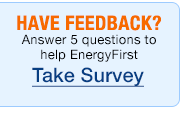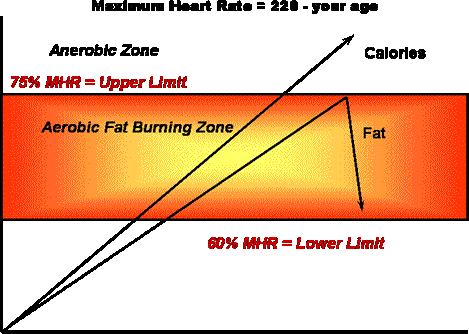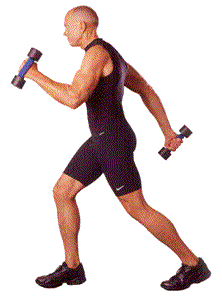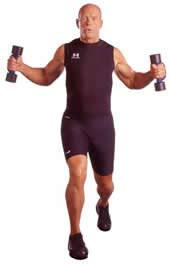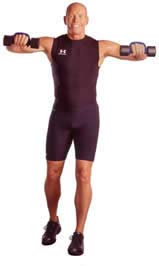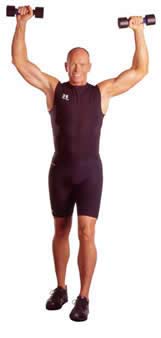President & CEO

Is your Exercise Program giving you results?Learn how to Exercise Effectively!Effective exercise means to exercise in a way that gives you the results you desire. If your aim is to reduce body fat, the key is to exercise in a manner that burns fat most efficiently. The 6 elements of effective exercise are: • Aerobic: You need an excess of oxygen to burn fat. You burn the most fat when you are exercising between 60% and 75% of your Maximum Heart Rate (calculated as 220 – your age). See the Training Heart Rate Model below for a full explanation. Example: For a 40 year old person, the Maximum Heart Rate = 220 – 40 = 180. Lower Limit = 0.6 X 180 = 108. Upper Limit = 0.75 X 180 = 135. Optimal fat burning zone = between 108 and 135 beats per minute. We recommend you wear a heart rate monitor to track your heart rate and ensure you remain in the aerobic zone. • Full body: When you use your upper and lower body simultaneously, you burn more fat. The more work you do at or above your heart, the better your cardiovascular fitness. 60% of your aerobic potential is from your waist up, while 40% of your aerobic potential is from your waist down. Walking while moving your upper body uses more of your lean mass than walking or running alone, therefore is more effective at burning fat and increasing cardiovascular fitness. • Weight bearing: This means bearing your full body weight. For example walking as opposed to swimming. With weight bearing exercise, you stimulate both your muscles and your bones, reducing the risk of osteoporosis. • Duration: Exercise for at least 30 minutes each time you exercise for best results. Increase duration to 45 minutes to an hour if you want to burn more fat. • Frequency: Exercise for at least three times a week for best results. Increase frequency to 5 or 6 days a week if you want to burn more fat. • Timing: First thing in the morning before eating is best. This is when insulin levels are the lowest. Remember, insulin blocks fat burning, so you will burn the most fat when your insulin levels are the lowest. But whenever exercise fits into your schedule is the best time. Training Heart Rate Model
• When you exercise you burn calories, but you only burn FAT up to a certain point. • After this point (indicated as your upper limit) the amount of body fat you burn drops dramatically. • Why? Your body needs a surplus of oxygen to burn fat. • This upper limit is the point at which your body can no longer supply oxygen fast enough to your cells to burn fat for fuel. • When you exceed this upper limit – your body switches energy systems from aerobic (technically meaning “with oxygen”) to an anaerobic energy system. In this state, your body burns mostly protein and carbohydrate and very little fat. • Key: To get lean and enhance cardiovascular fitness, train in your Aerobic Fat Burning Zone (between 60% and 75% of MHR). To ensure you stay within this zone, wear a Heart Rate Monitor (e.g. Polar). See the table below to determine your Aerobic zone heart rates. Target Heart Rate
The BEST Aerobic Exercise We have discovered Heavy Hands Walking , originally designed by Dr Leonard Schwartz MD, is the most efficient and effective exercise system for maximum energy, fat burning, cardiovascular fitness, and lean muscle enhancement. It is easy and practical and is appropriate for any age and any fitness levels. Dr Schwartz had been a non-athlete all his life. In fact, he was sedentary. He smoked and was overweight. In his fifties, he decided he needed to do something about the shape he was in. Today, Dr Leonard Schwartz is 76 years of age, 2% body fat with a resting heart rate of 32. He achieved this extraordinary state of health walking 30 minutes a day with Heavy Hands. What is Heavy Hands Walking? Heavy Hands Walking involves walking at a comfortable steady pace (approximately 3.0-3.5 miles per hour), pumping light hand weights. While walking you perform three different exercises with your hand weights (Chest Flyes, Lateral Raises, and Overhead Presses—for shorthand purposes, referred to as “F.L.O.”). You pump and walk to warm up and in between each set of the three exercises. What are the benefits? When you walk, you use only about 40% of your lean body mass (i.e. your muscles). Even when you run, you don't use much more (you just use the muscles you are already using a little harder). But with Heavy Hands walking, you are able to engage nearly 80% of your lean body mass. With so many muscles working, there is a tremendous amount of blood and oxygen demand being created. This stimulates your whole cardio-respiratory system (your heart, lungs, and blood vessels) to improve. Your resting heart rate will lower to reflect your strong heart and you'll have more energy all the time. Your stronger heart and more efficient lungs will be able to deliver more oxygen to your body and brain. More oxygen means more energy. Because you are working out in your aerobic zone, Heavy Hands walking is also an excellent way to reduce body fat. It is also a great way to tone and strengthen your whole body. Since you are using over 80% of your lean body mass, you are stimulating growth and improvement in most of your body. You will develop muscular endurance and tone. You will feel stronger and look firmer. Recommended Duration and frequency For maximum fat burning results, we recommend walking with Heavy Hands for a minimum of 30 minutes, at least 3 times every week. If you want to burn more fat, walk for longer periods (45 minutes to 1 hour), and more often (5-7 times a week). How do you progress? There are two variables: repetitions and weight . Weight: Both men and women start with 1-pound hand weights. This may seem light at first, but it is for good reason. You need to strengthen your connective tissues with a light weight to avoid injury when you progress to heavier weights. The goal for women is to progress to 4-5 pound hand weights (within 6 months), and for men, 6-8 pound hand weights (within 9-12 months) using the progression below. Repetitions: Increase your repetitions of each of the F. L. O. exercises every week over a six-week period (up to 6-pound weights). Then, at the end of 6 weeks, increase your hand weights by 1 pound, if you are comfortable doing so. Progression for repetitions : Week 1: 25 repetitions Week 2: 30 repetitions Week 3: 35 repetitions Week 4: 40 repetitions Week 5: 45 repetitions Week 6: 50 repetitions When you progress to 6 pound weights and over, increase your weight by one pound only after 12-weeks i.e. do 2 weeks of 25 reps, 2 weeks of 30 reps, 2 weeks of 40 reps, 2 weeks of 45 reps and 2 weeks of 50 reps before you increase your weight again. Only increase in weight when it feels comfortable for you. Listen to your body. Where can you do Heavy Hands? You can walk with Heavy Hands in the gym on a treadmill, on the spot or outside. If you use a treadmill, set the incline at 5.0 (to take the pressure off your knees) and set the speed at 3.0-3.5. Keep the speed constant unless you exceed 75% of your MHR (in which case slow the speed a little). If you have difficulty walking, you can just do the upper body movements standing still or walking on the spot, and you will still get significant aerobic benefit. Monitor your Heart Rate You burn the most fat when exercising aerobically. Your body is in an aerobic state when exercising between 60% and 75% of your Maximum Heart Rate. When you exceed your upper limit, you enter the anaerobic zone, where you burn little fat, and mainly protein and carbohydrates. Your Maximum Heart Rate = 220 and minus your age. So if you are 45, your maximum heart rate is 175. Your aerobic fat burning range then is calculated as: Lower Limit: 175 X .60 = 105. Your Upper Limit is: 175 X .75 = 131.25. When walking with Heavy Hands, to burn the most fat, keep your heart rate between 105 and 131.25. If you start exceeding the upper limit consistently throughout your walk, decrease the speed at which you are walking. Do not stop performing the upper body exercises. Note that when you do the overhead presses, your heart rate may go above your upper limit, but as long as your heart rate stays in the fat burning range most of the time, you do not need to slow down your pace. To monitor your heart rate, you can wear a heart rate monitor. You can buy one from any good sports store. Polar is a good brand. You can enter in your upper and lower limits, and an alarm will sound when your heart rate exceeds your upper limit. How do you do Heavy Hands? Below are some graphics illustrating how to perform these exercises with hand weights. “Pump & Walk” This is the basic movement. Pump and walk to warm up for 1 or 2 minutes before doing your F. L. and O. exercises, and as the rest break between the F. L. and O. exercises. You do one pump per step and stay in rhythm. This means that every time your right hand comes up, your left foot is coming off the ground. The actual arm movement is a curl, like a bicep curl, except you turn your wrist a 1/2 turn so your palms are facing each other and the Heavy Hand handle is pointing up. Walk for about 1-2 minutes (or 50 yards) or so to get your body warmed up.
After warming up with “pumping and walking,” perform one set of Chest Flyes. As you're walking, bring your Heavy Hands up to chest height with your knuckles facing each other. Then, keeping your elbows locked at a 90-degree angle, bring your elbows back as though you're trying to touch your elbows behind your back. Don't force it. Just do a range of motion that is comfortable for you. Listen to your body. Again, it's one pump per step. As your elbows come back, your left foot hits the ground. As your hands come back together, your right foot hits the ground. So it's left, right, left, right. One pump per step. After finishing your set of chest flyes, pump and walk for about a minute. |








